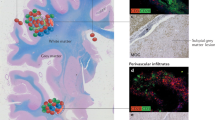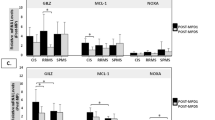Abstract
Autologous hematopoietic SCT (AHSCT) has been investigated in the past as a therapeutic alternative for multiple sclerosis (MS). Despite advances in clinical management, knowledge about mechanisms involved with clinical remission post transplantation is still limited. Abnormal microRNA and gene expression patterns were described in MS and have been suggested as disease biomarkers and potential therapeutic targets. Here we assessed T- and B-cell reconstitution, microRNAs and immunoregulatory gene expression after AHSCT. Early immune reconstitution was mainly driven by peripheral homeostatic proliferation. AHSCT increased CD4+CD25hiFoxP3+ regulatory T-cell counts and expression of CTLA-4 and GITR (glucocorticoid-induced TNFR) on CD4+CD25hi T cells. We found transient increase in exhausted PD-1+ T cells and of suppressive CD8+CD28−CD57+ T cells. At baseline, CD4+ and CD8+ T cells from MS patients presented upregulated miR-16, miR-155 and miR-142-3p and downregulated FOXP3, FOXO1, PDCD1 and IRF2BP2. After transplantation, the expression of FOXP3, FOXO1, PDCD1 and IRF2BP2 increased, reaching control levels at 2 years. Expression of miR-16, miR-155 and miR-142-3p decreased towards normal levels at 6 months post therapy, remaining downregulated until the end of follow-up. These data strongly suggest that AHSCT normalizes microRNA and gene expression, thereby improving the immunoregulatory network. These mechanisms may be important for disease control in the early periods after AHSCT.
This is a preview of subscription content, access via your institution
Access options
Subscribe to this journal
Receive 12 print issues and online access
$259.00 per year
only $21.58 per issue
Buy this article
- Purchase on Springer Link
- Instant access to full article PDF
Prices may be subject to local taxes which are calculated during checkout






Similar content being viewed by others
References
Farge D, Labopin M, Tyndall A, Fassas A, Mancardi GL, Van Laar J et al. Autologous hematopoietic stem cell transplantation for autoimmune diseases: an observational study on 12 years' experience from the European Group for Blood and Marrow Transplantation Working Party on Autoimmune Diseases. Haematologica 2010; 95: 284–292.
Snowden JA, Saccardi R, Allez M, Ardizzone S, Arnold R, Cervera R et al. Haematopoietic SCT in severe autoimmune diseases: updated guidelines of the European Group for Blood and Marrow Transplantation. Bone Marrow Transplant 2012; 47: 770–790.
Sullivan KM, Muraro P, Tyndall A . Hematopoietic cell transplantation for autoimmune disease: updates from Europe and the United States. Biol Blood Marrow Transplant 2010; 16 (Suppl): S48–S56.
Zhang L, Bertucci AM, Ramsey-Goldman R, Burt RK, Datta SK . Regulatory T cell (Treg) subsets return in patients with refractory lupus following stem cell transplantation, and TGF-beta-producing CD8+ Treg cells are associated with immunological remission of lupus. J Immunol 2009; 183: 6346–6358.
de Kleer I, Vastert B, Klein M, Teklenburg G, Arkesteijn G, Yung GP et al. Autologous stem cell transplantation for autoimmunity induces immunologic self-tolerance by reprogramming autoreactive T cells and restoring the CD4+CD25+ immune regulatory network. Blood 2006; 107: 1696–1702.
Alexander T, Thiel A, Rosen O, Massenkeil G, Sattler A, Kohler S et al. Depletion of autoreactive immunologic memory followed by autologous hematopoietic stem cell transplantation in patients with refractory SLE induces long-term remission through de novo generation of a juvenile and tolerant immune system. Blood 2009; 113: 214–223.
Muraro PA, Robins H, Malhotra S, Howell M, Phippard D, Desmarais C et al. T cell repertoire following autologous stem cell transplantation for multiple sclerosis. J Clin Invest 2014; 124: 1168–1172.
Muraro PA, Douek DC, Packer A, Chung K, Guenaga FJ, Cassiani-Ingoni R et al. Thymic output generates a new and diverse TCR repertoire after autologous stem cell transplantation in multiple sclerosis patients. J Exp Med 2005; 201: 805–816.
Darlington PJ, Touil T, Doucet JS, Gaucher D, Zeidan J, Gauchat D et al. Diminished Th17 (not Th1) responses underlie multiple sclerosis disease abrogation after hematopoietic stem cell transplantation. Ann Neurol 2013; 73: 341–354.
Abrahamsson SV, Angelini DF, Dubinsky AN, Morel E, Oh U, Jones JL et al. Non-myeloablative autologous haematopoietic stem cell transplantation expands regulatory cells and depletes IL-17 producing mucosal-associated invariant T cells in multiple sclerosis. Brain 2013; 136 (Part 9): 2888–2903.
Viglietta V, Baecher-Allan C, Weiner HL, Hafler DA . Loss of functional suppression by CD4+CD25+ regulatory T cells in patients with multiple sclerosis. J Exp Med 2004; 199: 971–979.
Huan J, Culbertson N, Spencer L, Bartholomew R, Burrows GG, Chou YK et al. Decreased FOXP3 levels in multiple sclerosis patients. J Neurosci Res 2005; 81: 45–52.
Lindsay MA . MicroRNAs and the immune response. Trends Immunol 2008; 29: 343–351.
Baltimore D, Boldin MP, O'Connell RM, Rao DS, Taganov KD . MicroRNAs: new regulators of immune cell development and function. Nat Immunol 2008; 9: 839–845.
Xiao C, Rajewsky K . MicroRNA control in the immune system: basic principles. Cell 2009; 136: 26–36.
Jr Ode F, Moore CS, Kennedy TE, Antel JP, Bar-Or A, Dhaunchak AS . MicroRNA dysregulation in multiple sclerosis. Front Genet 2012; 3: 311.
Keller A, Leidinger P, Steinmeyer F, Stähler C, Franke A, Hemmrich-Stanisak G et al. Comprehensive analysis of microRNA profiles in multiple sclerosis including next-generation sequencing. Mult Scler 2013; 20: 295–303.
Paraboschi EM, Soldà G, Gemmati D, Orioli E, Zeri G, Benedetti MD et al. Genetic association and altered gene expression of mir-155 in multiple sclerosis patients. Int J Mol Sci 2011; 12: 8695–8712.
Waschbisch A, Atiya M, Linker RA, Potapov S, Schwab S, Derfuss T . Glatiramer acetate treatment normalizes deregulated microRNA expression in relapsing remitting multiple sclerosis. PLoS One 2011; 6: e24604.
Liu X, Robinson SN, Setoyama T, Tung SS, D'Abundo L, Shah MY et al. FOXP3 is a direct target of miR15a/16 in umbilical cord blood regulatory T cells. Bone Marrow Transplant 2014; 49: 793–799 0.
Huang B, Zhao J, Lei Z, Shen S, Li D, Shen GX et al. miR-142-3p restricts cAMP production in CD4+CD25− T cells and CD4+CD25+ TREG cells by targeting AC9 mRNA. EMBO Rep 2009; 10: 180–185.
Saccardi R, Freedman MS, Sormani MP, Atkins H, Farge D, Griffith LM et al. A prospective, randomized, controlled trial of autologous haematopoietic stem cell transplantation for aggressive multiple sclerosis: a position paper. Mult Scler 2012; 18: 825–834.
Hamerschlak N, Rodrigues M, Moraes DA, Oliveira MC, Stracieri AB, Pieroni F et al. Brazilian experience with two conditioning regimens in patients with multiple sclerosis: BEAM/horse ATG and CY/rabbit ATG. Bone Marrow Transplant 2010; 45: 239–248.
Wu H, Neilson JR, Kumar P, Manocha M, Shankar P, Sharp PA et al. miRNA profiling of naïve, effector and memory CD8 T cells. PLoS One 2007; 2: e1020.
Lin SJ, Peacock CD, Bahl K, Welsh RM . Programmed death-1 (PD-1) defines a transient and dysfunctional oligoclonal T cell population in acute homeostatic proliferation. J Exp Med 2007; 204: 2321–2333.
Trabattoni D, Saresella M, Pacei M, Marventano I, Mendozzi L, Rovaris M et al. Costimulatory pathways in multiple sclerosis: distinctive expression of PD-1 and PD-L1 in patients with different patterns of disease. J Immunol 2009; 183: 4984–4993.
Thangavelu G, Parkman JC, Ewen CL, Uwiera RR, Baldwin TA, Anderson CC . Programmed death-1 is required for systemic self-tolerance in newly generated T cells during the establishment of immune homeostasis. J Autoimmun 2011; 36: 301–312.
Mollet L, Sadat-Sowti B, Duntze J, Leblond V, Bergeron F, Calvez V et al. CD8hi+CD57+ T lymphocytes are enriched in antigen-specific T cells capable of down-modulating cytotoxic activity. Int Immunol 1998; 10: 311–323.
Autran B, Leblond V, Sadat-Sowti B, Lefranc E, Got P, Sutton L et al. A soluble factor released by CD8+CD57+ lymphocytes from bone marrow transplanted patients inhibits cell-mediated cytolysis. Blood 1991; 77: 2237–2241.
Sykes M, Nikolic B . Treatment of severe autoimmune disease by stem-cell transplantation. Nature 2005; 435: 620–627.
Muraro PA, Douek DC . Renewing the T cell repertoire to arrest autoimmune aggression. Trends Immunol 2006; 27: 61–67.
Sun W, Popat U, Hutton G, Zang YC, Krance R, Carrum G et al. Characteristics of T-cell receptor repertoire and myelin-reactive T cells reconstituted from autologous haematopoietic stem-cell grafts in multiple sclerosis. Brain 2004; 127 (Part 5): 996–1008.
Hecker M, Thamilarasan M, Koczan D, Schroder I, Flechtner K, Freiesleben S et al. MicroRNA expression changes during interferon-beta treatment in the peripheral blood of multiple sclerosis patients. Int J Mol Sci 2013; 14: 16087–16110.
Murugaiyan G, Beynon V, Mittal A, Joller N, Weiner HL . Silencing microRNA-155 ameliorates experimental autoimmune encephalomyelitis. J Immunol 2011; 187: 2213–2221.
Zhang J, Braun MY . PD-1 deletion restores susceptibility to experimental autoimmune encephalomyelitis in miR-155-deficient mice. Int Immunol 2014; 26: 407–415.
Feng X, Petraglia AL, Chen M, Byskosh PV, Boos MD, Reder AT . Low expression of interferon-stimulated genes in active multiple sclerosis is linked to subnormal phosphorylation of STAT1. J Neuroimmunol 2002; 129: 205–215.
Keir ME, Butte MJ, Freeman GJ, Sharpe AH . PD-1 and its ligands in tolerance and immunity. Annu Rev Immunol 2008; 26: 677–704.
Freeman GJ, Long AJ, Iwai Y, Bourque K, Chernova T, Nishimura H et al. Engagement of the PD-1 immunoinhibitory receptor by a novel B7 family member leads to negative regulation of lymphocyte activation. J Exp Med 2000; 192: 1027–1034.
Salama AD, Chitnis T, Imitola J, Ansari MJ, Akiba H, Tushima F et al. Critical role of the programmed death-1 (PD-1) pathway in regulation of experimental autoimmune encephalomyelitis. J Exp Med 2003; 198: 71–78.
Baraut J, Grigore EI, Jean-Louis F, Khelifa SH, Durand C, Verrecchia F et al. Peripheral blood regulatory T cells in patients with diffuse systemic sclerosis (SSc) before and after autologous hematopoietic SCT: a pilot study. Bone Marrow Transplant 2014; 49: 349–354.
Wing K, Onishi Y, Prieto-Martin P, Yamaguchi T, Miyara M, Fehervari Z et al. CTLA-4 control over Foxp3+ regulatory T cell function. Science 2008; 322: 271–275.
McHugh RS, Whitters MJ, Piccirillo CA, Young DA, Shevach EM, Collins M et al. CD4(+)CD25(+) immunoregulatory T cells: gene expression analysis reveals a functional role for the glucocorticoid-induced TNF receptor. Immunity 2002; 16: 311–323.
Pfender N, Saccardi R, Martin R . Autologous hematopoietic stem cell transplantation as a treatment option for aggressive multiple sclerosis. Curr Treat Options Neurol 2013; 15: 270–280.
Acknowledgements
We acknowledge, thank and honor the memory of Professor Julio César Voltarelli, who led the HSCT studies for autoimmune disorders in Brazil. He prematurely passed away on 21 March 2012. We also thank the multiprofessional team of the Bone Marrow Transplantation Unit of the University Hospital at the Ribeirão Preto Medical School, University of São Paulo, Brazil, for their outstanding job with the patients. We furthermore acknowledge the laboratory personnel of the Hemotherapy Regional Blood Center of Ribeirão Preto, University of São Paulo, Brazil owing to their importance to this work. This work was supported by grants from CNPq and FAPESP.
Author Contributions
KCRM and MCO are the principal investigators and takes primary responsibility for the paper; LCMA, JCCL, APS, DLZ, PVBP and RAP performed the laboratory work for this study; MCO, DSB, BPS and AAB recruited the patients; DTC and WASJ coordinated the research; and LCMA, JCCL, KCRM and MCO wrote the paper.
Author information
Authors and Affiliations
Corresponding authors
Ethics declarations
Competing interests
The authors declare no conflict of interest.
Additional information
Supplementary Information accompanies this paper on Bone Marrow Transplantation website
Rights and permissions
About this article
Cite this article
Arruda, L., Lorenzi, J., Sousa, A. et al. Autologous hematopoietic SCT normalizes miR-16, -155 and -142-3p expression in multiple sclerosis patients. Bone Marrow Transplant 50, 380–389 (2015). https://doi.org/10.1038/bmt.2014.277
Received:
Revised:
Accepted:
Published:
Issue Date:
DOI: https://doi.org/10.1038/bmt.2014.277
This article is cited by
-
Agmatine-IRF2BP2 interaction induces M2 phenotype of microglia by increasing IRF2-KLF4 signaling
Inflammation Research (2023)
-
Autologous Hematopoietic Stem-Cell Transplantation in Multiple Sclerosis: A Systematic Review and Meta-Analysis
Neurology and Therapy (2022)
-
The current standing of autologous haematopoietic stem cell transplantation for the treatment of multiple sclerosis
Journal of Neurology (2022)
-
CCN3 is dynamically regulated by treatment and disease state in multiple sclerosis
Journal of Neuroinflammation (2020)
-
Tolerance regeneration by T regulatory cells in autologous haematopoietic stem cell transplantation for autoimmune diseases
Bone Marrow Transplantation (2020)



